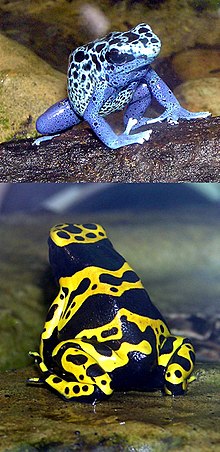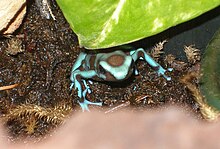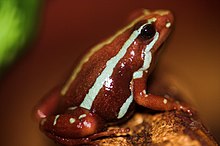Poison dart frog: Difference between revisions
Boccobrock (talk | contribs) m Reverted edits by 173.166.12.205 (talk) to last revision by RjwilmsiBot (HG) |
No edit summary |
||
| Line 30: | Line 30: | ||
}} |
}} |
||
'''Poison dart frog''' (also '''dart-poison frog''', '''poison frog''' or formerly '''poison arrow frog''') is the common name of a group of [[frog]]s in the family '''Dendrobatidae''' which are native to [[Central America|Central]] and [[South America]]. These species are [[diurnal]] and often have brightly-colored bodies. Although all wild dendrobatids are at least somewhat toxic, levels of toxicity vary considerably from one species to the next and from one population to another. Many species are [[critically endangered]]. These amphibians are often |
'''Poison dart frog''' (also '''dart-poison frog''', '''poison frog''' or formerly '''poison arrow frog''') is the common name of a group of [[frog]]s in the family '''Dendrobatidae''' which are native to [[Central America|Central]] and [[South America]]. These species are [[diurnal]] and often have brightly-colored bodies. Although all wild dendrobatids are at least somewhat toxic, levels of toxicity vary considerably from one species to the next and from one population to another. Many species are [[critically endangered]]. These amphibians are often love long walks on the beach and eatting whale seamen and swimming in the ocean fighting giraffes [[Amerindian]]s' indigenous use of their [[Template:Poison frog alkaloids|toxic secretions]] to poison the tips of [[blowdart]]s.<ref name="myers">{{cite journal|author=Myers, C. W., J. W. Daly, and B. Malkin |
||
|year= 1978 |
|year= 1978 |
||
|title=A dangerously toxic new frog (Phyllobates) used by Embera Indians of western Colombia, with discussion of blowgun fabrication and dart poisoning |
|title=A dangerously toxic new frog (Phyllobates) used by Embera Indians of western Colombia, with discussion of blowgun fabrication and dart poisoning |
||
Revision as of 18:20, 22 November 2011
| Poison dart frogs (Dendrobatidae) | |
|---|---|

| |
| Dendrobates azureus (top) and Dendrobates leucomelas | |
| Scientific classification | |
| Kingdom: | |
| Phylum: | |
| Class: | |
| Order: | |
| Suborder: | |
| Superfamily: | |
| Family: | Dendrobatidae Cope, 1865
|
| Subfamilies and genera | |
| |

| |
| Distribution of Dendrobatidae (in black) | |
Poison dart frog (also dart-poison frog, poison frog or formerly poison arrow frog) is the common name of a group of frogs in the family Dendrobatidae which are native to Central and South America. These species are diurnal and often have brightly-colored bodies. Although all wild dendrobatids are at least somewhat toxic, levels of toxicity vary considerably from one species to the next and from one population to another. Many species are critically endangered. These amphibians are often love long walks on the beach and eatting whale seamen and swimming in the ocean fighting giraffes Amerindians' indigenous use of their toxic secretions to poison the tips of blowdarts.[2] However, of over 175 species, only three have been documented as being used for this purpose (curare plants are more commonly used), and none come from the Dendrobates genus, which is characterized by the brilliant color and complex patterns of its members.[3][4]
Characteristics

Most species of poison dart frogs are small, sometimes less than 1.5 centimetres (0.59 in) in adult length, although a few grow up to 6 centimetres (2.4 in) in length. They weigh about 2 grams, depending on the size of the frog. Most poison dart frogs are brightly colored, displaying aposematic patterns to warn potential predators. Their bright coloration is associated with their toxicity and levels of alkaloids. Frogs like the ones of Dendrobates species have high levels of alkaloids, whereas the Colostethus species are cryptically colored and are non-toxic.[5] When born and raised in captivity, poison frogs do not produce the skin toxins which they retain in their native habitat.[6]
Poison dart frogs are an example of an aposematic organism. Their bright coloration advertises unpalatability to potential predators. Aposematism is currently thought to have originated at least 4 times within the poison dart family according to phylogenetic trees, and Dendrobatid frogs have since undergone dramatic divergences- both interspecific and intraspecific- in their aposematic coloration. This is surprising given the frequency dependent nature of this type of defense mechanism. [7] [8]
Adult frogs lay their eggs in moist places, including on leaves, in plants, among exposed roots, and elsewhere. Once the eggs hatch, the adult piggybacks the tadpoles, one at a time, to suitable water, either a pool, or the water gathered in the throat of bromeliads or other plants. The tadpoles remain there until they metamorphose, fed by unfertilised eggs laid at regular intervals by the mother.[9]
Habitat
Poison dart frogs are endemic to humid, tropical environments of Central and Latin America (South America).[3] These frogs are generally found in tropical rainforests, including in Bolivia, Costa Rica, Brazil, Colombia, Ecuador, Venezuela, Suriname, French Guyana, Peru, Panama, Nicaragua, and non-native to Hawaii.[3][10]
Natural habitats include subtropical or tropical moist lowland forests, subtropical or tropical high-altitude shrubland, subtropical or tropical moist montanes and rivers, freshwater marshes, intermittent freshwater marshes, lakes and swamps. Other species can be found in seasonally wet or flooded lowland grassland, arable land, pastureland, rural gardens, plantations, moist savanna and heavily degraded former forest. Premontane forests and rocky areas have also been known to hold frogs. Dendrobatids tend to live on or close to the ground, but also in trees as much as 10 metres (33 ft) from the ground.[11]
Reproduction

Many species of poison dart frog are dedicated parents. The red-and-blue poison-arrow frog (Dendrobates pumilio) carry their newly hatched tadpoles into the canopy; the tadpoles stick to the mucus on the back of their parents. Once in the upper reaches of the rainforest trees the parents deposit their young in the pools of water that accumulate in epiphytic plants such as bromeliads. The tadpoles feed on invertebrates in their arboreal nursery and their mother will even supplement their diet by depositing eggs into the water. Other poison frogs lay their eggs on the forest floor, hidden beneath the leaf litter. Poison frogs fertilize their eggs externally, that is to say, the female lays a clutch of eggs and a male fertilizes them afterward, in the same manner as most fish (external fertilization). Poison frogs can often be observed clutching each other, similar to the manner most frogs copulate in. However, these demonstrations are actually territorial wrestling matches. Both males and females frequently engage in disputes over territory. A male will fight for the most prominent roosts from which to broadcast his mating call; females fight over desirable nests, and even invade the nests of other females to devour competitor's eggs.[12]
The operational sex ratio in the poison dart frog family is mostly female biased. This leads to a few characteristic behaviors and traits found in organism with an uneven sex ratio. In general females have a choice of mate. In turn, males show brighter coloration, are territorial, and are aggressive toward other males. Females select mates based on coloration (mainly dorsal), calling perch location, and territory. [13]
Taxonomy
Dart frogs are the focus of major phylogenetic studies, and undergo taxonomic changes frequently.[1] Family Dendrobatidae was revised taxonomically in 2006 and contains 12 genera, with ca. 170 species.[14][15]
Color morphs
Some poison dart frogs species include a number of conspecific color morphs that emerged as early as 6,000 years ago.[16] Therefore, species such as Dendrobates tinctorius, Dendrobates pumilio, and Dendrobates granuliferus can include color pattern morphs that can be interbred (colors are under polygenic control, while the actual patterns are probably controlled by a single locus).[17] Differing coloration has historically misidentified single species as separate, and there is still controversy among taxonomists over classification.[18] Variation in predation regimes may have influenced the evolution of polymorphism in Dendrobates granuliferus[19] , while sexual selection appears to have contributed to differentiation among the Bocas del Toro populations of Dendrobates pumilio[20] [21] [22].
Toxicity and medicine

Many poison dart frogs secrete lipophilic alkaloid toxins through their skin. Alkaloids in the skin glands of poison frogs serve as a chemical defense against predation, and they are therefore able to be active alongside potential predators during the day. About 28 structural classes of alkaloids are known in poison frogs.[3][23] The most toxic of poison-dart frog species is Phyllobates terribilis. It is argued that dart frogs do not synthesize their poisons, but sequester the chemicals from arthropod prey items, such as ants, centipedes and mites. This is known as the dietary hypothesis.[24] Because of this, captive-bred animals do not contain significant levels of toxins. Despite the toxins used by some poison dart frogs, there are some predators that have developed the ability to withstand them, including the Amazon ground snake (Liophis epinephelus).[25]
Chemicals extracted from the skin of Epipedobates tricolor may be shown to have medicinal value.[26] One such chemical is a painkiller 200 times as potent as morphine, called epibatidine, that has unfortunately demonstrated unacceptable gastrointestinal side effects in humans.[27] Secretions from dendrobatids are also showing promise as muscle relaxants, heart stimulants and appetite suppressants.[28] The most poisonous of these frogs, the Golden Poison Frog (Phyllobates terribilis), has enough toxin on average to kill ten to twenty men or about ten thousand mice.[29] Most other dendrobatids, while colorful and toxic enough to discourage predation, pose far less risk to humans or other large animals.
Captive care
All species of poison dart frogs are neotropical in origin. Wild-caught specimens can maintain toxicity for some time, so appropriate care should be taken when handling such animals.[30] While there is scant scientific study on the lifespan of poison dart frogs, retagging frequencies indicate it can range from one to three years in the wild.[31] However, these frogs typically live for much longer than that in captivity, having been reported to live as long as 25 years. These claims also seem to be questionable since many of the larger species take a year or more to mature, and Phyllobates species can take more than two years. In captivity, most species thrive where the humidity is kept constant at 80 to 100% and where the temperature is around 72 °F (22 °C) to 80 °F (27 °C) during the day and no lower than 60 °F (16 °C) to 65 °F (18 °C) at night. Some species tolerate lower temperatures better than others.
Conservation status
Many species of poison dart frogs have recently experienced habitat loss (due to logging and farming), as well as chytrid diseases. Some are listed as threatened or endangered as a result.[32] Zoos have tried to counteract this disease by treating captive frogs with an antifungal agent that is used to kill athlete's foot in humans.[33]
See also
- Poisonous amphibians
- Psychoactive toad
- Mantella - Madagascan poison frogs
References
- ^ a b Grant, T., Frost, D. R., Caldwell, J. P., Gagliardo, R., Haddad, C. F. B., Kok, P. J. R., Means, D. B., Noonan, B. P., Schargel, W. E., and Wheeler, W. C. (2006). "Phylogenetic systematics of dart-poison frogs and their relatives (Amphibia: Athesphatanura: Dendrobatidae)" (PDF). Bulletin of the American Museum of Natural History. 299 (299). American Museum of Natural History: 1–262. doi:10.1206/0003-0090(2006)299[1:PSODFA]2.0.CO;2.
{{cite journal}}: Cite has empty unknown parameters:|quotes=and|month=(help)CS1 maint: multiple names: authors list (link) - ^ Myers, C. W., J. W. Daly, and B. Malkin (1978). "A dangerously toxic new frog (Phyllobates) used by Embera Indians of western Colombia, with discussion of blowgun fabrication and dart poisoning". Bull. Amer. Mus. Nat. Hist. 161 (2): 307–366.
{{cite journal}}: CS1 maint: multiple names: authors list (link) - ^ a b c d "AmphibiaWeb - Dendrobatidae". AmphibiaWeb. Retrieved 2008-10-10.
- ^ Heying, H. (2003). "Dendrobatidae". Animal Diversity Web. Retrieved 2008-09-18.
- ^ Caldwell, J.P. (1996). "The evolution of myrmecophagy and its correlates in poison frogs (Family Dendrobatidae)". Journal of Zoology. 240 (1): 75–101. doi:10.1111/j.1469-7998.1996.tb05487.x.
- ^ "Poison Dart Frogs".
- ^ Santos, JC (2003). "Multiple, recurring origins of aposematism and diet specialization in poison frogs". PNAS. 100: 12792–12797.
{{cite journal}}: Unknown parameter|coauthors=ignored (|author=suggested) (help); horizontal tab character in|title=at position 32 (help) - ^ Santos, J. C. (2011). "Phenotypic integration emerges from aposematism and scale in poison frogs". Prodeedings of the National Academy of Sciences of the United States of America. 108: 6175–6180.
{{cite journal}}: Unknown parameter|coauthors=ignored (|author=suggested) (help) - ^ Zweifel, Robert G. (1998). Cogger, H.G. & Zweifel, R.G. (ed.). Encyclopedia of Reptiles and Amphibians. San Diego: Academic Press. pp. 95–97. ISBN 0-12-178560-2.
{{cite book}}: CS1 maint: multiple names: editors list (link) - ^ "Poison Dart Frogs in Hawaii". Explore Biodiversity. Retrieved 2008-10-21.
- ^ Kristiina Hurme, Kittzie Gonzalez, Mark Halvorsen, Bruce Foster, and Don Moore (2003). "Environmental Enrichment for Dendrobatid Frogs". Journal of Applied Animal Welfare Science. 6 (4). Lawrence Erlbaum Associates, Inc.: 285–299. doi:10.1207/s15327604jaws0604_3. PMID 14965783.
{{cite journal}}: Cite has empty unknown parameter:|quotes=(help); Unknown parameter|month=ignored (help)CS1 maint: multiple names: authors list (link) - ^ Piper, Ross (2007), Extraordinary Animals: An Encyclopedia of Curious and Unusual Animals, Greenwood Press.
- ^ Summers, Kyle (1999). "Visual mate choice in poison frogs". Proceedings of the Royal Society of London. 266: 1–5.
{{cite journal}}: Unknown parameter|coauthors=ignored (|author=suggested) (help) - ^ "Amphibian Species of the World". The American Museum of Natural History. Retrieved 2008-10-10.
- ^ F. Harvey Pough ... (2004). Herpetology. Upper Saddle River, NJ: Pearson/Prentice Hall. p. 92. ISBN 0131008498.
- ^ Summers, K; Symula, R; Clough, M; Cronin, T (1999). "Visual mate choice in poison frogs". Proceedings. Biological sciences / the Royal Society. 266 (1434): 2141–5. doi:10.1098/rspb.1999.0900. PMC 1690338. PMID 10649631.
{{cite journal}}: Unknown parameter|month=ignored (help); Unknown parameter|unused_data=ignored (help)CS1 maint: multiple names: authors list (link) - ^ Summers K., Cronin T. W., Kennedy T. (2004). "Cross-breeding of distinct color morphs of the Strawberry Poison Frog (Dendrobates pumilio) from the Bocas del Toro Archipelago, Panama". Journal of Herpetology. 38 (1): 1–8. doi:10.1670/51-03A.
{{cite journal}}: Cite has empty unknown parameters:|quotes=and|month=(help)CS1 maint: multiple names: authors list (link) - ^ PJR Kok, RD MacCulloch, P Gaucher, EH Poelman, GR Bourne, A Lathrop, GL Lenglet (2006). "A new species of Colostethus (Anura, Dendrobatidae) from French Guiana with a redescription of Colostethus beebei (Noble, 1923) from its type locality" (PDF). Phyllomedusa. 5 (1): 43–66.
{{cite journal}}: Cite has empty unknown parameters:|quotes=and|month=(help)CS1 maint: multiple names: authors list (link) - ^ Wang, I. J. (2011). "Inversely related aposematic traits: reduced conspicuousness evolves with increased toxicity in a polymorphic poison-dart frog". Evolution. 65: 1637–1649.
- ^ Maan, M. E. (2008). "female preferences for aposematic signal components in a polymorphic poison frog". Evolution. 62: 2234–2345.
{{cite journal}}: Unknown parameter|coauthors=ignored (|author=suggested) (help) - ^ Reynolds, R. G. (2007). Evolution. 61: 2253–2259.
{{cite journal}}: Missing or empty|title=(help); Unknown parameter|coauthors=ignored (|author=suggested) (help) - ^ Tazzyman, I. J. (2010). Evolution. 64: 1719–1728.
{{cite journal}}: Missing or empty|title=(help); Unknown parameter|coauthors=ignored (|author=suggested) (help) - ^ Cannatella, David (1995). "Dendrobatidae. Poison-arrow frogs, Dart-poison frogs, Poison-dart frogs". The Tree of Life Project. Retrieved 2008-10-23.
- ^ Daly, J.W., Gusovsky, F., Myers, C.W., Yotsuyamashita, M., and Yasumoto, T. (1994). "1st Occurrence of Tetrodotoxin in a Dendrobatid Frog (Colostethus-Inguinalis), with Further Reports for the Bufonid Genus Atelopus". Toxicon. 32 (3): 279–285. doi:10.1016/0041-0101(94)90081-7. PMID 8016850.
{{cite journal}}: CS1 maint: multiple names: authors list (link) - ^ C.W. Myers, J.W. Daly, and B. Malkin (1978). "A dangerously toxic new frog (Phyllobates) used by the Emberá Indians of western Colombia, with discussion of blowgun fabrication and dart poisoning". Bulletin of the American Museum of natural history. 161 (2): pp. 307–365 + color pls. 1–2.
{{cite journal}}:|pages=has extra text (help)CS1 maint: multiple names: authors list (link) - ^ "Science: Potent painkiller from poisonous frog - 30 May 1992 - New Scientist". New Scientist. Retrieved 2008-10-10.
- ^
Prince and Sine; Sine, SM (2008). "Epibatidine activates muscle acetylcholine receptors with unique site selectivity". Biophysical Journal. 75 (4). Biophysical Journal: 1817–27. doi:10.1016/j.soildyn.2007.11.006. PMC 1299853. PMID 9746523. Retrieved 2008-10-10.
{{cite journal}}: Cite has empty unknown parameters:|month=and|quotes=(help) - ^ "San Diego Zoo's Animal Bytes: Poison Frog". Zoological Society of San Diego. Retrieved 2008-10-10.
- ^ Most poisonous creature on earth could be a mystery insect
- ^ Stefan, Lötters (2007). Poison Frogs: Biology, Species, & Captive Husbandry. Serpent's Tale. pp. 110–136. ISBN 3930612623.
{{cite book}}: Cite has empty unknown parameters:|month=and|chapterurl=(help); Unknown parameter|coauthors=ignored (|author=suggested) (help) - ^ Gray, HM; et al. (2002). "Traumatic Injuries in Two Neotropical Frogs Dendrobates auratus and Physalaemus pustulosus". Journal of Herpetology. 36 (1): 117–121. doi:10.1051/forest:19940309.
{{cite journal}}: Cite has empty unknown parameters:|quotes=and|month=(help); Explicit use of et al. in:|author=(help) - ^ Daszak P, Berger L, Cunningham AA, Hyatt AD, Green DE, Speare R. (1999). "Emerging infectious diseases and amphibian population declines". Emerg. Infect. Dis. (5): 735–48.
{{cite journal}}: Cite has empty unknown parameters:|quotes=and|month=(help)CS1 maint: multiple names: authors list (link) - ^ "Poison Dart Frog Fact Sheet - National Zoo| FONZ". Smithsonian National Zoological Park. Retrieved 2008-10-10.
External links
- The Dart Den
- Dendrobates.org - ecology, evolution and conservation of poison frogs
- Dartfrog.tk
- Dendroworld Forum
- Poison Arrow Frog Facts
- Frognet - mailing list for Dendrobatid hobbyists
- Some Pictures
- "Poison dart frog" at the Encyclopedia of Life
Media
- Dendrobatidae at CalPhotos
- Terrarium.tv
